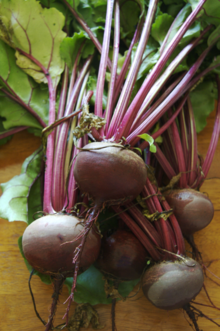Beet
| Beetroot | |
|---|---|

Beetroot
|
|
| Species | Beta vulgaris |
| Subspecies | Beta vulgaris subsp. vulgaris |
| Cultivar group | 'Conditiva' group |
| Origin | Sea beet (Beta vulgaris subsp. maritima) |
| Cultivar group members | Many; see text. |
| Nutritional value per 100 g (3.5 oz) | |
|---|---|
| Energy | 180 kJ (43 kcal) |
|
9.96 g
|
|
| Sugars | 7.96 g |
| Dietary fiber | 2.0 g |
|
0.18 g
|
|
|
1.68 g
|
|
| Vitamins | |
| Vitamin A equiv. |
(0%)
2 μg |
| Thiamine (B1) |
(3%)
0.031 mg |
| Riboflavin (B2) |
(2%)
0.027 mg |
| Niacin (B3) |
(2%)
0.331 mg |
| Pantothenic acid (B5) |
(3%)
0.145 mg |
| Vitamin B6 |
(5%)
0.067 mg |
| Folate (B9) |
(20%)
80 μg |
| Vitamin C |
(4%)
3.6 mg |
| Minerals | |
| Calcium |
(2%)
16 mg |
| Iron |
(6%)
0.79 mg |
| Magnesium |
(6%)
23 mg |
| Manganese |
(14%)
0.3 mg |
| Phosphorus |
(5%)
38 mg |
| Potassium |
(6%)
305 mg |
| Sodium |
(5%)
77 mg |
| Zinc |
(4%)
0.35 mg |
|
|
| Percentages are roughly approximated using US recommendations for adults. Source: USDA Nutrient Database |
|
The beetroot is the taproot portion of the beet plant, usually known in North America as the beet, also table beet, garden beet, red beet, or golden beet. It is one of several of the cultivated varieties of Beta vulgaris grown for their edible taproots and their leaves (called beet greens). These varieties have been classified as B. vulgaris subsp. vulgaris Conditiva Group.
Other than as a food, beets have use as a food colouring and as a medicinal plant. Many beet products are made from other Beta vulgaris varieties, particularly sugar beet.
Usually the deep purple roots of beetroot are eaten boiled, roasted or raw, and either alone or combined with any salad vegetable. A large proportion of the commercial production is processed into boiled and sterilized beets or into pickles. In Eastern Europe, beet soup, such as borscht, is a popular dish. In Indian cuisine, chopped, cooked, spiced beet is a common side dish. Yellow-coloured beetroots are grown on a very small scale for home consumption.
The green, leafy portion of the beet is also edible. The young leaves can be added raw to salads, whilst the adult leaves are most commonly served boiled or steamed, in which case they have a taste and texture similar to spinach. Those greens selected should be from bulbs that are unmarked, instead of those with overly limp leaves or wrinkled skins, both of which are signs of dehydration. The domestication of beets can be traced to the emergence of an allele which enables biennial harvesting of leaves and taproot.
Beetroot can be boiled or steamed, peeled and then eaten warm with or without butter as a delicacy; cooked, pickled, and then eaten cold as a condiment; or peeled, shredded raw, and then eaten as a salad. Pickled beets are a traditional food in many countries.
A traditional Pennsylvania Dutch dish is pickled beet egg. Hard-boiled eggs are refrigerated in the liquid left over from pickling beets and allowed to marinate until the eggs turn a deep pink-red colour.
...
Wikipedia
